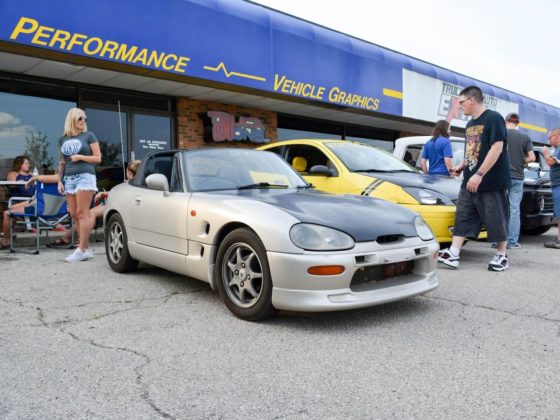
We have been off-roading in our Tundra much more frequently lately and with our new suspension, we discovered something interesting about high performance off road suspension. When going fast over rough terrain, the better your suspension is, the better everything is until suddenly it isn’t! We discovered this when going over a whoop section in our truck at about 70 mph. Everything was great until suddenly the whoop-de-doo’s got a lot bigger and the pitch of the whoops changed drastically to disagree with the truck’s wheelbase. Throw in a rock pile and that we were sliding around a bend. This caused us to bottom out the suspension really hard and almost lose control completely which somehow we didn’t. Note that this speed was probably 4x faster than what was possible in the stock truck! This drama damaged the front end of the truck slightly, something bent, throwing off the alignment, and of course, we could have crashed. The whole thing was due to bad judgment and a lack of off-roading experience on our part. So of course more mods were needed to improve the suspension and to strengthen the front suspension’s weak points. First, to improve the suspension, we once again asked Icon Vehicle Dynamics for some help.

To give our suspension even more capability, for our main front coilovers, we selected Icon’s 3.0 series front shocks to replace our current 2.5 series front shocks. The 3.0 shock is a very high-tech dual-piston design with a multi-stage hydraulic bottoming control that exponentially increases bottoming resistance over the last 40% of shock travel. This makes it virtually impossible to bottom the front suspension harshly. The 3.0 shock has a huge 3″ piston which is 50% bigger than the 2.5 version we are currently running and once the secondary piston is engaged, there is 100% more piston area than the 2.5 shocks. The more piston area, the more bearing area for strength and long life. Also, with a bigger piston, there is more fluid flow for more precise damping control and more available damping force.

The 3.0 shock has a larger 10″ remote reservoir, bigger than the 2.5’s 6″ one. This adds to the fluid capacity for better cooling and also adds additional volume to make up for the increased shaft and piston displacement. Inside the reservoir, there is a floating piston that keeps the shock fluid separate from the nitrogen gas that pressurizes the shock. Running the shocks at about 250 psi of gas pressure reduces cavitation and foaming when the fluid is forced through the valves at high velocity. This keeps the damping consistent even under hard use. Inside the reservoir, like the 2.5 shocks, is Icon’s CDC adjustable compression damping valve. This adjustment mostly affects low-speed compression damping which controls roll and dive under braking. There are 10 clicks of adjustment on the CDC valve here on the knob as shown on the of the reservoir.

The Icon 3.0 shocks have an eye type FK upper bearing. This allows for a longer shaft with more travel while maintaining a shorter body that fits within the confines of the stock shock tower. The anti-corrosive cad plated adjusting collar for the chrome-silicon Eibach spring is on top, where the threads are more protected from rock hits. This is because the shock is an inverted design where the heavy body of the shock is attached to the chassis and the lighter shock rod is attached to the suspension. This reduces unsprung weight which allows the suspension to work better. When you are talking about suspension with massive heavy-duty offroad main shocks and big secondary bypass shocks, the unsprung weight reduction by going inverted can become pretty significant. The Icon 3.0 coilovers are adjustable from 1.65-3.7 inches higher than stock to accommodate extra travel and larger tires.



4 comments
The dual piston design looks like it would be awesome for mountain bikes, too.
What do you guys think about using an oleo damper for off-road vehicles? It seems like it would work pretty well. I know that they use them on tanks.
https://en.m.wikipedia.org/wiki/Oleo_strut
An oleo strut is a damper with a gas spring. Gas springs are progressive which may or may not be a good thing.
“Solid-spring shock absorbers, however, suffer from low efficiency,
Efficiency = A / (L x S)
where A is the energy absorbed by the strut during its stroke, L is the maximum load on the strut during the stroke, and S is the maximum stroke resulting from the maximum load.”
“ Some oleo struts contain a tapered metering rod that moves along with the piston through the center of the orifice to vary the orifice size. This continuously adjusts the rate at which hydraulic fluid enters the upper chamber, allowing a higher rate of flow at the moment of touchdown and progressively lowering flow rate as the strut reaches its point of maximum compression. This optimizes the magnitude and duration of force on the airframe due to the landing loads, spreading the force over the longest duration possible and keeping the force relatively constant over that duration.”
It seems like you could benefit from the non-linear air spring response in off-road applications. I know that someone is using an oleo damper on a MTB, but I think it’s absurdly expensive. From I heard, it can use a linear linkage, but still have significant bottom out resistance.
https://m.pinkbike.com/news/brew-nitro-shox-eurobike-2015.html
“The whole thing was due to bad judgment and a lack of off-roading experience on our part. So of course more mods were needed to improve the suspension and to strengthen the front suspension’s weak points.” I just have to laugh because that’s a very familiar rabbit hole in general.
That said, the secondary pistons are pretty darned cool – it’s not relevant to stuff I do but I love seeing valving tricks that offroad stuff (be it this kind of thing or rally) come up with to handle extreme situations.